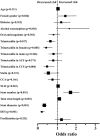Predictors of restenosis following percutaneous coronary stent implantation: The role of trimetazidine therapy
- PMID: 35935652
- PMCID: PMC9353214
- DOI: 10.3389/fcvm.2022.873899
Predictors of restenosis following percutaneous coronary stent implantation: The role of trimetazidine therapy
Abstract
Aims: In-stent restenosis (ISR) is an unresolved problem following percutaneous coronary intervention (PCI), having a negative impact on clinical outcome. The main goal of this study was to find new independent predictors that may influence the development of ISR.
Methods and results: In this retrospective analysis, 653 PCI patients were involved. All patients had coronary stent implantation and a follow-up coronary angiography. Based on the presence of ISR at follow-up, patients were divided into two groups: 221 in the ISR and 432 in the control group. When evaluating the medical therapy of patients, significantly more patients were on trimetazidine (TMZ) in the control compared to the ISR group (p = 0.039). TMZ was found to be an independent predictor of a lower degree of ISR development (p = 0.007). TMZ treatment was especially effective in bare metal stent (BMS)-implanted chronic coronary syndrome (CCS) patients with narrow coronary arteries. The inflammation marker neutrophil to lymphocyte ratio (NLR) was significantly elevated at baseline in the ISR group compared to controls. The reduction of post-PCI NLR was associated with improved efficacy of TMZ to prevent ISR development. Drug eluting stent implantation (p < 0.001) and increased stent diameter (p < 0.001) were the most important independent predictors of a lower degree of ISR development, while the use of longer stents (p = 0.005) was a major independent predictor of an increased ISR risk.
Conclusion: TMZ reduces the occurrence of ISR following PCI, with special effectiveness in BMS-implanted patients having CCS and narrow coronary arteries. TMZ treatment may help to lower ISR formation in countries with high BMS utilization rates.
Keywords: anti-inflammatory effect; in-stent restenosis; percutaneous coronary intervention (PCI); stent implantation; trimetazidine (TMZ).
Copyright © 2022 Csató, Erdei, Ványai, Balla, Czuriga, Csanádi, Koszegi, Édes and Szabó.
Figures



References
LinkOut - more resources
Full Text Sources
Miscellaneous

